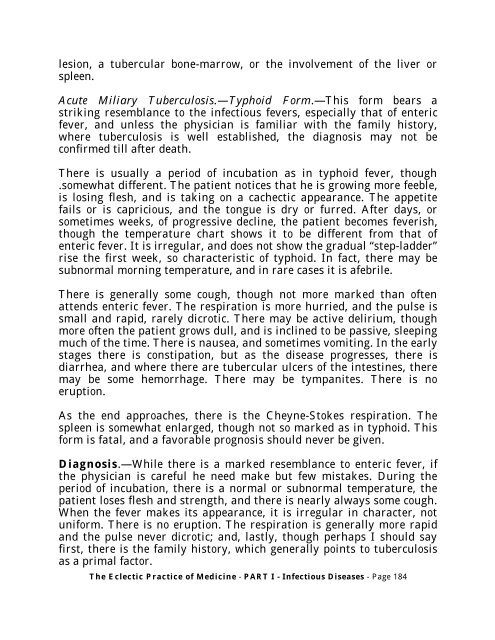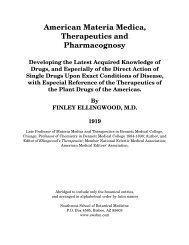SCARLET FEVER. Synonyms.—Scarlatina; Scarlet Rash. Definition ...
SCARLET FEVER. Synonyms.—Scarlatina; Scarlet Rash. Definition ...
SCARLET FEVER. Synonyms.—Scarlatina; Scarlet Rash. Definition ...
You also want an ePaper? Increase the reach of your titles
YUMPU automatically turns print PDFs into web optimized ePapers that Google loves.
lesion, a tubercular bone-marrow, or the involvement of the liver or<br />
spleen.<br />
Acute Miliary Tuberculosis.—Typhoid Form.—This form bears a<br />
striking resemblance to the infectious fevers, especially that of enteric<br />
fever, and unless the physician is familiar with the family history,<br />
where tuberculosis is well established, the diagnosis may not be<br />
confirmed till after death.<br />
There is usually a period of incubation as in typhoid fever, though<br />
.somewhat different. The patient notices that he is growing more feeble,<br />
is losing flesh, and is taking on a cachectic appearance. The appetite<br />
fails or is capricious, and the tongue is dry or furred. After days, or<br />
sometimes weeks, of progressive decline, the patient becomes feverish,<br />
though the temperature chart shows it to be different from that of<br />
enteric fever. It is irregular, and does not show the gradual “step-ladder”<br />
rise the first week, so characteristic of typhoid. In fact, there may be<br />
subnormal morning temperature, and in rare cases it is afebrile.<br />
There is generally some cough, though not more marked than often<br />
attends enteric fever. The respiration is more hurried, and the pulse is<br />
small and rapid, rarely dicrotic. There may be active delirium, though<br />
more often the patient grows dull, and is inclined to be passive, sleeping<br />
much of the time. There is nausea, and sometimes vomiting. In the early<br />
stages there is constipation, but as the disease progresses, there is<br />
diarrhea, and where there are tubercular ulcers of the intestines, there<br />
may be some hemorrhage. There may be tympanites. There is no<br />
eruption.<br />
As the end approaches, there is the Cheyne-Stokes respiration. The<br />
spleen is somewhat enlarged, though not so marked as in typhoid. This<br />
form is fatal, and a favorable prognosis should never be given.<br />
Diagnosis.—While there is a marked resemblance to enteric fever, if<br />
the physician is careful he need make but few mistakes. During the<br />
period of incubation, there is a normal or subnormal temperature, the<br />
patient loses flesh and strength, and there is nearly always some cough.<br />
When the fever makes its appearance, it is irregular in character, not<br />
uniform. There is no eruption. The respiration is generally more rapid<br />
and the pulse never dicrotic; and, lastly, though perhaps I should say<br />
first, there is the family history, which generally points to tuberculosis<br />
as a primal factor.<br />
The Eclectic Practice of Medicine - PART I - Infectious Diseases - Page 184

















